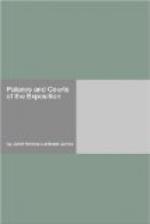These are called respectively “The Dome of Philosophy” and “The Dome of Plenty.” The female figures carrying the books “Ex libris,” as well as the male figures carrying cereal wreaths, are by Albert Weinert and Earl Cummings, respectively.
“Out of books comes much knowledge,” says the woman.
“If you wish to be as physically strong as I am, eat my food,” says the man. This figure then represents physical vigor.
The fountains of the vestibules are by W. B. Faville of San Francisco. That in the vestibule of the Palace of Food Products is strongly reminiscent of the fountain of Perugia.
The great Siena pedestals beside these palaces carry Ralph Stackpole’s “Thought.”
The niches have alternate groups of “Abundance” and “Triumph of the Fields,” both by Chas. Harley of Philadelphia (studio in New York).
Abundance expresses to you the overflowing amount of all that we have today. Her symbol, the cornucopia, is seen on either side. Her large hands are spread out as if to say:
“I give you all that I have. Take. Choose what you will.”
One certainly has a bountiful choice.
The eagle’s head is on the prow of the vessel in which she sits. It surely suggests that considering all we have put before us today, we have reason for inspiration (the eagle being the symbol of inspiration).
The Triumph of the Fields shows man surrounded by the symbols of the harvest festivals when the Celtic cross, to take one case, or the standard with the bull atop, to take another, was carried through the fields at the time of the bringing in of the harvests.
Man has been the guiding hand to the bull, but the bull has really triumphed since it has actually done the work, while man receives the credit. Man has surmounted the bull, as it were.
Above is the wheel of the wain of old.
The seed in the black earth appears almost to possess intelligence. You get that idea by the head below. Has not the seed produced the bearded barley head you see represented? Does not that power of production appear to be intelligence in the seed?
Below the niches are facsimiles of old Roman baths such as one sees in the Lateran Museum, in Rome. (See picture in Bannister Fletcher’s History of Architecture, page 170.)
Fronting the Esplanade are four great palaces:
The Palace of Food Products, which allows you to see how a number of our dry groceries are made;
The Palace of Agriculture, dealing with the many interests of the farmer and the orchardist, the fisheries, forestry, reclaimed land, etc.;
The Palace of Transportation, which enables one to see the remarkable progress made in automobiles, aerial navigation, ocean liners, overland trains, etc.;
The Palace of Mines, which has been spoken of before.
These four palaces have the same kind of doorway. The style is the Spanish Plateresque, the same kind of work that was used on the fine portals of the Palace of Varied Industries.




